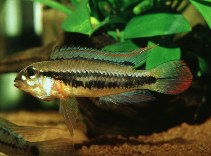| Family: |
Cichlidae (Cichlids), subfamily: Geophaginae |
| Max. size: |
2.92 cm SL (male/unsexed); 4.5 cm TL (female) |
| Environment: |
benthopelagic; freshwater; pH range: 6 - 6.5; dH range: 6 - 20 |
| Distribution: |
South America: Amazon River basin, in the middle Negro River from San Carlos to the Arirará River. |
| Diagnosis: |
Vertebrae: 24-25. This elongate (depth 25.1-27.8% of SL), relatively small (<30 mm SL) species is distinguished by the following set of characters: presence of anguloarticular lateralis canal; four lateralis canal foramina on dentary; two infraorbital bones, second with three foramina; serrated posttemporal, supracleithrum and preoperculum; bi- or tri-serial jaw dentition; no scales on anterior chest region; males with low dorsal fin, caudal fin elongately rounded, soft dorsal, anal and pelvic fins with prolonged tips; a unique colour pattern with two horizontal bands on side, converging posteriorly and anteriorly, a ventrally widened suborbital stripe continued across branchiostegal membrane and 3 spots associated with pectoral fin base (2 on medial side of axilla, 1 on lateral side on bases of rays) (Ref. 86447). |
| Biology: |
Eggs are deposited on the ceiling of caves and are tendered by the female parent (Ref. 47893). Attains a maximum length 2.92 cm SL (Ref. 98797). |
| IUCN Red List Status: |
Not Evaluated (N.E.) Ref. (130435)
|
| Threat to humans: |
harmless |
| Country info: |
|
Source and more info: www.fishbase.org. For personal, classroom, and other internal use only. Not for publication.

